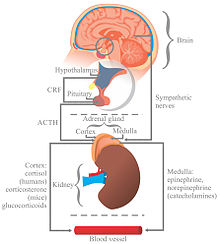
Back Stres Afrikaans ضغط نفسي Arabic توتر ARZ Estrés AST Stres Azerbaijani ایسترس AZB Стрэс Byelorussian Стрэс BE-X-OLD Стрес Bulgarian Estrès Catalan


Stress, whether physiological, biological or psychological, is an organism's response to a stressor such as an environmental condition.[1] When stressed by stimuli that alter an organism's environment, multiple systems respond across the body.[2] In humans and most mammals, the autonomic nervous system and hypothalamic-pituitary-adrenal (HPA) axis are the two major systems that respond to stress.[3] Two well-known hormones that humans produce during stressful situations are adrenaline and cortisol.[4]
The sympathoadrenal medullary (SAM) axis may activate the fight-or-flight response through the sympathetic nervous system, which dedicates energy to more relevant bodily systems to acute adaptation to stress, while the parasympathetic nervous system returns the body to homeostasis.
The second major physiological stress-response center, the HPA axis, regulates the release of cortisol, which influences many bodily functions such as metabolic, psychological and immunological functions. The SAM and HPA axes are regulated by several brain regions, including the limbic system, prefrontal cortex, amygdala, hypothalamus, and stria terminalis.[3] Through these mechanisms, stress can alter memory functions, reward, immune function, metabolism and susceptibility to diseases.[5]
Disease risk is particularly pertinent to mental illnesses, whereby chronic or severe stress remains a common risk factor for several mental illnesses.[6][7]
- ^ Nachiappan, Vasanthi; Muthukumar, Kannan (December 2010). "Cadmium-induced oxidative stress in Saccharomyces cerevisiae". Indian Journal of Biochemistry and Biophysics. 47 (6): 383–387. ISSN 0975-0959. PMID 21355423. Archived from the original on 25 July 2019. Retrieved 1 August 2019.
- ^ Muthukumar, Kannan; Nachiappan, Vasanthi (1 December 2013). "Phosphatidylethanolamine from Phosphatidylserine Decarboxylase2 is Essential for Autophagy Under Cadmium Stress in Saccharomyces cerevisiae". Cell Biochemistry and Biophysics. 67 (3): 1353–1363. doi:10.1007/s12013-013-9667-8. ISSN 1559-0283. PMID 23743710. S2CID 16393480.
- ^ a b Ulrich-Lai, Yvonne M.; Herman, James P. (7 February 2017). "Neural Regulation of Endocrine and Autonomic Stress Responses". Nature Reviews Neuroscience. 10 (6): 397–409. doi:10.1038/nrn2647. ISSN 1471-003X. PMC 4240627. PMID 19469025.
- ^ "Biology of stress". CESH / CSHS. Retrieved 27 September 2022.
- ^ Stephens, Mary Ann C.; Wand, Gary (1 January 2012). "Stress and the HPA Axis". Alcohol Research: Current Reviews. 34 (4): 468–483. ISSN 2168-3492. PMC 3860380. PMID 23584113.
- ^ Notaras, Michael; van den Buuse, Maarten (3 January 2020). "Neurobiology of BDNF in fear memory, sensitivity to stress, and stress-related disorders". Molecular Psychiatry. 25 (10): 2251–2274. doi:10.1038/s41380-019-0639-2. ISSN 1476-5578. PMID 31900428. S2CID 209540967.
- ^ Segerstrom, Suzanne C.; Miller, Gregory E. (7 February 2017). "Psychological Stress and the Human Immune System: A Meta-Analytic Study of 30 Years of Inquiry". Psychological Bulletin. 130 (4): 601–630. doi:10.1037/0033-2909.130.4.601. ISSN 0033-2909. PMC 1361287. PMID 15250815.
© MMXXIII Rich X Search. We shall prevail. All rights reserved. Rich X Search